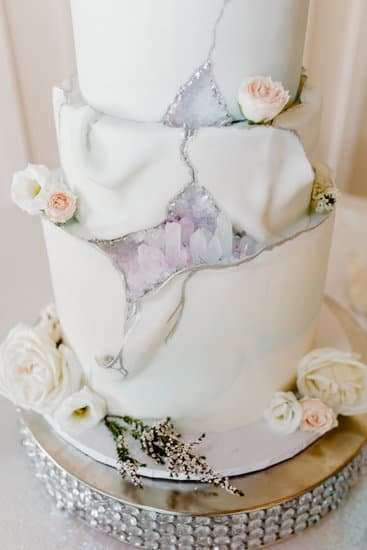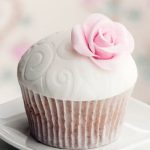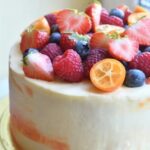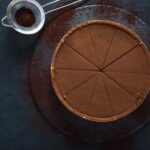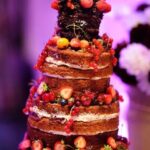Decorating a cake is not just an afterthought; it is an integral part of the baking process that elevates the overall presentation and appeal of the dessert. Whether it’s a simple birthday cake or an extravagant wedding centerpiece, cake decoration plays a crucial role in capturing attention and creating a lasting impression. In this article, we will delve into the world of cake decoration, exploring why it is important and how it enhances the visual delight of any cake.
Humans are innately drawn to visually appealing objects, and cakes are no exception. A beautifully decorated cake can instantly captivate anyone’s attention and make their mouths water. The colors, shapes, and textures used in cake decoration have the power to evoke emotions and set the tone for any celebration. From vibrant floral designs to intricate piping details, every element on a decorated cake tells a story and adds to its overall charm.
In addition to enhancing visual appeal, cake decoration also serves practical purposes. It helps create a smooth canvas for frosting application, hides imperfections in the baking process, and provides structural support for layered cakes. Moreover, decorating a cake allows bakers to showcase their creativity by experimenting with different techniques like piping, fondant sculpting, or edible painting.
To achieve stunning results in cake decoration, several essential tools are needed. These basic tools include spatulas for spreading frosting smoothly, piping bags for precise designs, tips for creating various patterns and textures, and a cake turntable for easy access from all angles. These fundamental tools form the foundation of any beginner decorator’s toolkit. However, as decorators advance in their skills and ambitions, they may explore additional tools like stencils for intricate designs or airbrush systems for flawless gradients.
Now that we understand why decorating a cake is important let’s explore further by diving into the essential tools required for this creative endeavor.
Essential Tools for Cake Decoration
Cake decoration requires a few essential tools to achieve professional-looking results. Whether you are a beginner or an experienced decorator, having the right tools can make a significant difference in your cake decorating journey.
List of Basic Tools Needed
To start off, there are four basic tools that every cake decorator should have: a spatula, piping bags, tips, and a cake turntable. A spatula is essential for spreading frosting smoothly and evenly on the cake’s surface.
Piping bags and tips allow you to create intricate designs or add borders to your cakes. The cake turntable is a handy tool that helps in rotating the cake while decorating, ensuring even application of frosting and easy access to all sides of the cake.
Explanation of Each Tool and Its Purpose
A spatula helps in spreading frosting on the top, sides, and corners of the cake effortlessly. There are offset and straight spatulas available depending on personal preference. Piping bags are usually made from disposable plastic or reusable cloth materials and come in various sizes.
They enable precise control over the flow of frosting while creating different patterns or designs on the cake. Paired with piping bags, tips play an important role in determining the shape and size of the piped design. From round tips for lettering to star-shaped tips for delicate borders, there is a wide variety available to suit every design preference.
Lastly, a cake turntable provides stability and convenience during the decoration process by allowing easy rotation without disturbing the icing or decorations already applied.
Additional Tools for Advanced Decorators
For more advanced decorators looking to take their skills to the next level, there are additional tools worth considering. These tools include an offset spatula for precision work, fondant smoother for achieving smooth fondant coatings on cakes, flower nails for creating beautiful sugar flowers, and modeling tools for shaping intricate fondant details.
Having these essential tools in your arsenal will certainly help you on your cake decorating journey. However, it is important to note that while these tools are beneficial, it is ultimately the decorator’s creativity and skill that will bring the cake to life.
With practice and experimentation, decorators can go beyond the basic tools and explore innovative techniques to create stunning cakes that are sure to impress. So, gather your tools and get started on your next cake decorating adventure.
Types of Frosting for Cake Decoration
When it comes to decorating a cake, choosing the right frosting is crucial. Frosting serves as both the canvas and the medium for any decorations you add to your cake. It helps bring your design to life while also providing a deliciously sweet finish. In this section, we will explore three popular types of frosting for cake decoration: buttercream, fondant, and whipped cream.
Buttercream Frosting
Buttercream frosting is a classic choice for cake decoration due to its versatility and smooth texture. Made with butter, powdered sugar, and flavorings such as vanilla or chocolate, buttercream holds up well in different climates and can be easily tinted with colors for added visual appeal. To achieve a smooth application of buttercream frosting, it is recommended to use an offset spatula or a bench scraper to spread an even layer on the cake.
For those looking to get creative with buttercream frosting on their cakes, various decorating techniques can be employed. Some popular ones include piped rosettes, basket weaves, or simple borders using different piping tips. A word of advice when working with buttercream: make sure your cake is properly chilled before adding intricate designs to prevent the frosting from melting.
Fondant
Fondant is another type of frosting widely used in cake decoration due to its polished appearance and ability to create structured designs. Fondant is made by combining gelatin, sugar syrup, and water into a pliable dough that can be rolled out and draped over a cake for a smooth finish. It provides a clean canvas for intricate decorations.
Rolling out fondant requires patience and practice. It should be large enough to cover the entire cake without tearing or stretching too thin. Once placed on the cake, excess fondant can be trimmed away using a sharp knife or pizza cutter. Fondant allows decorators to create unique designs such as bows, ribbons, or sculpted figurines, taking cake decoration to a whole new level.
Whipped Cream
For those looking for a lighter and less sweet frosting option, whipped cream can be the perfect choice. Made by whipping heavy cream with sugar until it reaches stiff peaks, whipped cream adds a delightful freshness to any cake. However, it is important to note that whipped cream does not hold up as well in warm environments and is best suited for cakes that will be refrigerated.
Decorating with whipped cream can be relatively simple yet elegant. It can be piped using different tips to create rosettes or borders on the cake’s surface. Alternatively, fresh fruits like berries or citrus slices can be incorporated into the whipped cream design to enhance the overall aesthetic appeal.
| Type of Frosting | Advantages | Decorating Ideas |
|---|---|---|
| Buttercream | Versatile and smooth texture | Piped rosettes, basket weaves, borders |
| Fondant | Polished appearance and structured designs | Bows, ribbons, sculpted figurines |
| Whipped Cream | Light and fresh option | Piped rosettes, incorporating fruits |
Edible Decorations for Cake
When it comes to decorating cakes, using edible decorations adds a delightful touch and enhances the overall presentation. Edible decorations not only provide visual appeal but also offer additional flavors and textures to the cake. In this section, we will explore some popular edible decorations that can take your cake decorating skills to the next level.
Candies and chocolates are versatile edible decorations that can be used in various shapes and colors. They can be arranged strategically on top of the cake or used to create intricate designs and patterns. For example, colorful sprinkles or small candies can be scattered over a buttercream frosted cake to add a playful touch. On the other hand, chocolate shavings or curls can be used to create elegant borders or accents on fondant-covered cakes.
Fresh fruits are another excellent option for adding both color and flavor to your decorated cake. Depending on the season and personal preference, you can use a variety of fruits such as berries, slices of citrus fruits, or tropical fruits like kiwi or mango.
Fruits can be carefully arranged into beautiful patterns or used as garnishes on top of a whipped cream frosted cake. The natural sweetness and vibrant colors of fresh fruits bring a refreshing taste that complements any cake design.
Nuts and sprinkles provide not only visual interest but also an added texture and crunch to your decorated cake. Chopped nuts such as almonds, pecans, or walnuts can be sprinkled over frosting for an earthy richness or used to decorate the sides of the cake for a rustic finish.
Sprinkles come in various shapes, sizes, and colors, allowing decorators endless possibilities for creativity. From tiny metallic beads for an elegant touch to rainbow-colored jimmies for a festive look, sprinkles are sure to bring joy and excitement to any celebration.
By incorporating these edible decorations into your cake designs, you can transform an ordinary-looking confection into a work of art. Remember to have fun experimenting with different textures, colors, and flavors to create unique and stunning cake decorations that will impress your friends and family.
Essential Cake Decorating Techniques
Decorating a cake requires not only creativity and artistic skills but also knowledge of essential cake decorating techniques. These techniques are crucial in achieving a beautifully decorated cake that looks as good as it tastes. In this section, we will explore some of the most important cake decorating techniques that every aspiring baker should know.
One vital technique is crumb coating. This involves applying a thin layer of frosting to the cake before adding the final layer. Crumb coating helps to seal in any loose crumbs and provides a smooth base for the final layer of frosting.
To achieve a perfect crumb coat, start by spreading a thin layer of frosting over the entire cake using a spatula. Then, refrigerate the cake for around 20 minutes to allow the frosting to set before applying the final coat.
Another popular technique is piping, which involves using a piping bag and various tips to create decorative designs on the cake’s surface. Beginners can start with simple designs such as dots or stars and gradually progress to more intricate patterns like flowers or lace borders. It is important to practice control and consistency while piping, as this will greatly affect the overall appearance of the design.
Working with fondant is another essential skill for cake decorators. Fondant is a pliable icing that can be rolled out and used to cover cakes for a smooth finish. To cover a cake seamlessly with fondant, start by rolling it out into a large circle or rectangle, depending on the shape of your cake.
Carefully drape the fondant over the cake, smoothing it down gently with your hands or a fondant smoother to eliminate any wrinkles or air bubbles. Remember to apply a thin layer of buttercream frosting underneath the fondant to help it adhere better.
| Technique | Description |
|---|---|
| Crumb Coating | Applying a thin layer of frosting to seal in crumbs and create a smooth base |
| Piping | Using a piping bag and tips to create decorative designs on the cake’s surface |
| Fondant | A pliable icing that can be rolled out and used to cover cakes for a smooth finish |
Mastering these essential cake decorating techniques will give you a solid foundation for creating beautifully decorated cakes. It is important to practice these techniques and experiment with different designs to develop your own style. With time and dedication, you will be able to create stunning and personalized cakes that are sure to impress.
Creative Cake Decorating Ideas
When it comes to cake decoration, there are limitless possibilities for unleashing your creativity. Whether you are baking a cake for a birthday, wedding, or any special occasion, incorporating unique and innovative designs can elevate the overall appeal of your cake. In this section, we will explore some creative cake decorating ideas that will surely impress your guests.
One popular trend in cake decoration is theme-based cakes. These cakes are tailored to a specific event or occasion and reflect its essence. For example, for a child’s birthday party, you can create a cake that resembles their favorite cartoon character or superhero. For a beach-themed wedding, you can design a cake with edible seashells and sugar sand. The possibilities are endless, and themed cakes add an extra element of excitement to any celebration.
In addition to theme-based cakes, innovative designs have become increasingly popular among cake decorators. Geode cakes, which mimic the sparkling beauty of gemstones by using vibrant rock candy or sugar crystals inside the cake layers, have gained significant attention on social media platforms.
Another eye-catching design is the ombre layering technique, where different shades of color are seamlessly blended from one layer to another. Floral arrangements made from edible flowers such as roses and dahlias have also become a favorite choice for those looking for an elegant touch.
Personalization is another way to make your decorated cake truly special. Incorporating names, messages, or even photos on cakes adds a personal touch that will be appreciated by the recipient. A wedding cake with the couple’s initials carved delicately on top or a birthday cake adorned with edible images of cherished memories can evoke emotions and make the celebration even more meaningful.
Remember that these ideas are just starting points; let your imagination run wild. Experiment with various techniques and designs to find your own unique style. With practice and inspiration from online tutorials and resources, you’ll soon be able to create beautifully decorated cakes that will be the centerpiece of any gathering. So go ahead, embrace your creativity and have fun decorating.
Tips and Tricks for Beginners
Decorating a cake can be both exciting and challenging, especially for beginners. To help you get started on your cake decorating journey, here are some useful tips and tricks to keep in mind:
- Start with simple designs and gradually progress: As a beginner, it’s best to begin with basic designs before attempting more complex ones. Practice techniques like smooth frosting application, simple piping, and using basic edible decorations. This will allow you to build confidence and develop your skills as you go.
- Practice piping techniques on parchment paper: Piping is a fundamental skill in cake decorating and requires practice to master. Before piping directly onto your cake, try practicing different piping patterns and designs on parchment paper first. This will give you a better understanding of how the icing flows and allows you to make adjustments before moving onto the actual cake.
- Utilize online tutorials and resources for inspiration: The internet is a treasure trove of cake decorating tutorials, videos, blogs, and forums where you can find inspiration and guidance from experienced decorators. Take advantage of these resources to learn new techniques, get ideas for creative designs, and troubleshoot any issues you may encounter along the way.
By following these tips and tricks, beginners can gain confidence in their cake decorating skills and create beautiful cakes that are sure to impress. Remember that practice makes perfect – don’t be discouraged if your first few attempts aren’t flawless. With time and dedication, your cake decorating skills will improve, allowing you to create stunning cakes that are both visually appealing and delicious.
So go ahead, let your creativity soar as you embark on this delightful journey of cake decoration.
Cake Decoration Mistakes to Avoid
Decorating a cake can be a fun and creative process, but it’s important to be aware of common mistakes that can hinder the final result. By avoiding these pitfalls, you can ensure that your cake not only looks visually appealing but also tastes delicious. Here are some cake decoration mistakes to avoid:
Over-decorating: Finding the Right Balance
When it comes to cake decoration, less is often more. It’s easy to get carried away with adding too many embellishments and decorations, resulting in a cluttered and overwhelming design. To avoid this mistake, remember the importance of balance and simplicity in your cake design. Choose a focal point or a few key elements to highlight rather than attempting to include every decoration possible.
Rushing: Allowing Enough Time for Detailed Designs
Cake decoration requires time and patience, especially when working on intricate designs. One mistake that beginners often make is rushing through the process or not allocating enough time for each step. Allow yourself plenty of time to work on your design so that you can give attention to detail and ensure smooth execution.
Lack of Planning: Visualizing the Final Design
Before you begin decorating your cake, it’s essential to have a clear plan in mind or even sketch out your design on paper. Not having a vision for the final result can lead to a messy or disjointed look. Take some time to brainstorm ideas, consider color schemes, and visualize how different elements will come together before diving into the decoration process.
By avoiding these common cake decoration mistakes, you’ll be able to create beautifully decorated cakes that are visually impressive and enjoyable for both the eyes and taste buds. Remember, practice makes perfect, so don’t get discouraged if your first attempts don’t turn out exactly as planned. With time and experience, you’ll develop your own unique style and master the art of cake decoration.
Conclusion
In conclusion, this article has provided readers with a comprehensive guide on decorating cakes. By understanding the importance of visually appealing cakes and how cake decoration enhances the overall presentation, readers are motivated to experiment and create their own beautifully decorated cakes.
Throughout the article, essential tools for cake decoration have been discussed, including the spatula, piping bags, tips, and cake turntable. Additional tools for advanced decorators have also been mentioned for those wanting to take their skills to the next level.
Furthermore, various types of frosting were explored, such as buttercream frosting, fondant, and whipped cream. Each type was explained in detail along with recipes, application tips, and creative decorating ideas.
The article also delved into edible decorations for cakes, including candies and chocolates, fresh fruits, nuts, and sprinkles. Readers were provided with insights on how to use these decorations to add texture and complement the design of their cakes.
In addition to discussing essential cake decorating techniques like crumb coating and piping designs, the article touched on creative ideas such as theme-based cakes and innovative designs like geode cakes or floral arrangements. Personalization was also highlighted as a way to make cakes truly unique.
Lastly, this article empowers readers by providing tips for beginners and highlighting common mistakes to avoid. By urging readers to start small and gradually progress while utilizing online resources for inspiration and guidance from tutorials, readers are encouraged to develop their skills.
To conclude, this article encourages readers to embrace the joy of cake decoration by experimenting with different techniques and styles. The author invites readers to share their beautifully decorated creations with both themselves and the wider blogging community. With the knowledge gained from this comprehensive guide on cake decoration, readers are now empowered to bring their artistic visions to life through beautifully decorated cakes.
Frequently Asked Questions
What does a beginner need for cake decorating?
For beginners in cake decorating, there are a few essential items that are needed to get started. Firstly, a beginner would need basic baking tools such as measuring cups and spoons, mixing bowls, and a mixer or whisk for preparing the cake batter. Additionally, it is important to have a good quality cake pan in the desired shape and size.
To decorate the cake, basic tools like an offset spatula or palette knife for spreading frosting, piping bags with different tips for creating various designs, and a turntable for easy rotating of the cake are necessary. Lastly, an assortment of food coloring gels or liquids can be helpful in achieving vibrant colors for frosting.
What are the three essentials of cake decorating?
The three essentials of cake decorating are frosting/icing, piping bags/tips, and a smooth surface to work on. Frosting serves as both the glue that holds the layers of the cake together as well as the medium for decorating it. Whether it is buttercream or fondant icing, having a well-prepared frosting is crucial for successful decoration.
Piping bags and tips allow decorators to create beautiful patterns and designs on their cakes. Different tips create different shapes such as stars or rosettes, giving each cake its unique style. Finally, having a smooth surface on which to work is important for achieving even spreads of frosting and clean lines on your design.
What is the thing used to decorate cakes called?
The thing used to decorate cakes is commonly referred to as “cake decorations” or “cake decorating supplies.” These can encompass various items depending on the specific needs of the decorator’s project.
Some common types of decorations include edible elements like sprinkles, edible glitter dusts, or fondant shapes that can be added directly onto the frosted surface of the cake. Non-edible decorations like plastic figurines or sugar flowers can also be used to enhance the appearance of a cake but should be removed before serving since they are not meant to be consumed.

Welcome to our cake decorating blog! My name is Destiny Flores, and I am the proud owner of a cake decorating business named Cake Karma. Our mission is to provide delicious, beautiful cakes for all occasions. We specialize in creating custom cakes that are tailored specifically to each customer’s individual needs and tastes.

